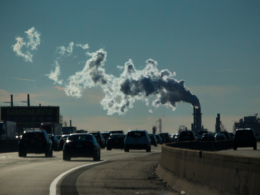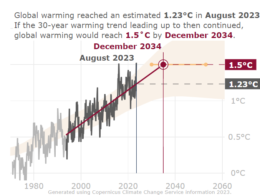the health strategist
institute for strategic health transformation
& digital health
Joaquim Cardoso MSc.
Chief Research and Strategy Officer (CRSO),
Chief Editor and Senior Advisor
August 28, 2023
What is the message?
The article underscores the political neglect of extreme heat in California’s climate initiatives, despite it being responsible for more deaths than all other weather events combined.
The state’s focus on appealing topics like new technology and renewable energy has overshadowed the urgent need to address the impacts of extreme heat, particularly on lower-income families.
Advocates are struggling to secure funding, enforce regulations, and generate political momentum to adequately address the escalating dangers of extreme heat.
INFOGRAPHIC

One page summary:
Extreme heat, despite its deadly impact on residents, struggles to gain political traction in California’s climate agenda. Despite being responsible for more fatalities than all other weather events combined, extreme heat funding remains a small fraction of California’s climate budget. This article highlights the challenges of pushing policymakers to prioritize this issue.
California, a state known for pioneering outdoor heat standards for workers and enacting laws to manage heat waves, has not been able to effectively address the political aspect of extreme heat.
Political attention has been more focused on attractive topics like new technology, electric vehicles, and rooftop solar. This has left lower-income families, who are most vulnerable to the impacts of extreme heat due to lack of access to air conditioning and existing health issues, largely neglected.
The magnitude of extreme heat’s impact became evident after data revealed that high temperatures led to nearly 4,000 deaths between 2010 and 2019 in California, a number significantly higher than official estimates. This surpasses fatalities caused by other dramatic weather events like wildfires and floods.
The state’s response has been lacking in terms of data collection and enforcement. Efforts to collect real-time data from emergency rooms to monitor heat-related illnesses are yet to become operational.
The agency responsible for workplace regulations has not finalized rules for indoor job sites, despite deadlines being set. Enforcement of existing regulations for outdoor workers has been hindered by staffing shortages.
Funding for extreme heat programs has also been inconsistent. Despite initial budget allocation, significant cuts were made, raising concerns among advocates. Governor Gavin Newsom’s office emphasizes existing programs but does not directly address the need for increased spending on extreme heat.
Advocates are disappointed by the reduced funding for resilience centers that offer shelter during heatwaves. They are pushing for increased funding through a bond proposal, aiming for substantial investment to address the growing issue of extreme heat. However, competition with other bond measures and limited resources pose challenges.
To garner support, advocates seek engagement from powerful labor unions, considering the potential for retrofitting housing and installing heat pumps. The prevalence of older, inefficient housing in California presents an opportunity for creating jobs while addressing extreme heat vulnerabilities.
In conclusion, despite its deadly consequences, extreme heat struggles to gain political attention in California’s climate agenda. Advocates are grappling with funding cuts, delayed enforcement, and challenges in prioritizing this issue. The push for increased funding and engagement with labor unions aims to tackle this growing problem and create sustainable solutions.
DEEP DIVE

Extreme heat is on everyone’s lips. Too bad it can’t get political traction
Extreme heat funding is a tiny fraction of California’s climate budget, despite killing more residents than all other weather events combined
Politico
Alexander Nieves
August 16, 2023
Even in California, home of the nation’s first outdoor heat standard for workers and a new law to create a ranking system for heat waves, the issue has yet to gain political traction. | David McNew/Getty Images
LOS ANGELES — Scorching summer temperatures have pushed extreme heat to the front of the nation’s collective consciousness. There’s just one problem: It’s hard to get politicians to care about it.
Even in California, home of the nation’s first outdoor heat standard for workers and a new law to create a ranking system for heat waves, the issue has yet to gain political traction. Advocates have struggled to secure funding to help residents adapt, and state officials have been slow to enforce worker safety rules.
California’s handling of extreme heat doesn’t bode well for the nation’s ability to address the effects of rising temperatures, which are most likely to harm people who can’t access air conditioning and who are already in poor health.
“Our focus has been on priorities where you can get people to buy in and, frankly, where it’s sexy. It’s new technology, it’s talking about electric vehicles and rooftop solar,” said state Sen. Anna Caballero, a Central Valley Democrat who represents rural communities that are among the poorest in the state. “We haven’t focused on the impacts of climate change on lower-income families.”
While President Joe Biden announced a federal effort last week to track heat-related illnesses, California officials began paying closer attention to heat deaths in 2021, after the Los Angeles Times estimated that high temperatures had killed nearly 4,000 people between 2010 and 2019 — more than six times higher than official state figures.
The data dwarfs fatalities from more dramatic extreme weather events like wildfires, floods and windstorms. Fewer than 300 Californians died from those events over the same period of time, according to data from the National Weather Service.

“That was a shock to the department,” said Paul English, a former epidemiologist with the California Department of Public Health and director of the Public Health Institute’s Tracking California program, which publishes environmental health data. “I think the issue was really a lack of understanding about the magnitude of the problem.”
Lawmakers last year directed the state’s public health department to build a system for collecting real-time data from emergency rooms, but it’s not up and running yet. Officials don’t know when it will be operational, telling POLITICO that it’s still in the planning phase.
Meanwhile, Cal/OSHA, the agency tasked with developing the state’s workplace regulations, has yet to finalize rules for hot indoor job sites like warehouses and restaurants, despite lawmakers originally setting a 2019 deadline. And while California established the nation’s first outdoor heat standard for workers in 2005, enforcement has proven difficult. More than a third of Cal/OSHA’s 349 enforcement positions are currently unfilled, according to the latest figures published by the state.
A survey of 1,500 farmworkers conducted by the UC Merced Community and Labor Center earlier this year found around half of those interviewed said their employers didn’t always provide required rest breaks, and a quarter said they didn’t always have access to clean drinking water.
And while Gov. Gavin Newsom, a Democrat, touted some $865 million in last year’s budget for multiyear extreme heat programs, like grants for local governments and funding for planting trees, he and lawmakers cut nearly 40 percent of that money this year to close a deficit. Advocates argue that even before the cuts, heat spending represented a tiny fraction of a $54 billion climate package.
A pilot project created last year to build “community resilience centers” as shelter during heat waves lost its entire $160 million budget for next year. The cuts haven’t stopped Newsom from praising California’s response to extreme heat, including in press releases that highlighted the same community resilience center program that’s losing funding next year.
Newsom’s office didn’t directly address a question on whether he believes the state should spend more on extreme heat, instead highlighting existing programs and saying in a statement that “California is taking more action than ever before to keep people safer.”
Advocates are feeling disheartened by what the cuts portend for California — and the nation’s — willingness to pony up for extreme heat.
“Climate justice is raised up as a priority often by the governor’s office and legislature, but to roll back this program, despite many other funds being maintained, is extremely disappointing,” said Amee Raval, policy and research director for the Asian Pacific Environmental Network, one of the groups that has spearheaded the push for resilience centers.
Groups are hoping to get more funding via a bond proposal that could appear before voters next year, which would allow the state to finance environmental programs with borrowed money. They’re pushing lawmakers to include more than the $500 million to $1.6 billion currently envisioned for extreme heat programs.
But the climate proposal will have to compete with several other bond measures for limited cash and space on the ballot — and there’s a recognition that however much they secure, it won’t be enough.
“Five hundred million dollars isn’t going to get us there,” Caballero said. “$1.5 billion is better, but I have a feeling that when you add it all up, it’s a whole heck of a lot more than that. It may be as much as $100 billion. And so the question becomes, are we willing to make that kind of investment?”
Environmental justice and public health groups are hoping that the prospect of retrofitting housing and installing heat pumps will entice politically powerful labor unions to get involved. They’re looking to groups like a relatively new coalition of 13 unions, including SEIU California, the California Federation of Teachers and United Steelworkers, which is planning to release a policy platform this fall that will include extreme heat.
There’s a lot of work — and potential profit — to go around.
About two-thirds of California’s 14 million homes and apartment units were built before the state strengthened its energy efficiency rules in 1981, according to Bob Raymer, technical director of the California Building Industry Association. That means many of these dwellings have little to no insulation, thin windows and substandard roofing materials that cause internal temperatures to skyrocket on hot days.
This is particularly true in historically cooler regions, like the Bay Area, where sustained heatwaves are becoming more common, and formerly redlined neighborhoods, which often consist of cheaply built housing units and lack tree canopies that provide vital shade.
“I think the work of this clean energy transition, in the context of worsening disasters and extreme heat, are absolutely jobs that we want to ensure are family-sustaining union jobs, and that there are pathways to organize our communities,” Raval said.
But absent more political muscle, advocates are banking on heat itself to generate more momentum.
“If there’s anything we have going for us at the moment,” said Enrique Huerta, legislative director for Climate Resolve, a nonprofit that advocates for local climate solutions, “it’s that the weather is really hot in Sacramento.”
Originally published at https://www.politico.com












